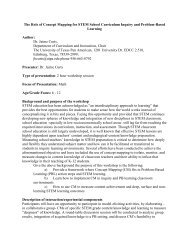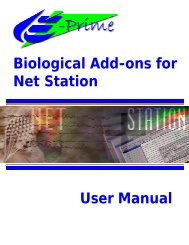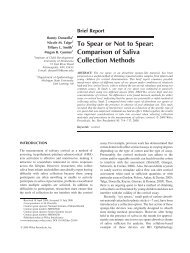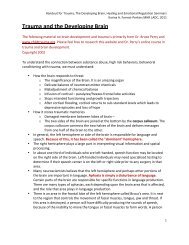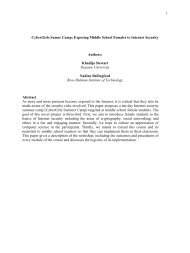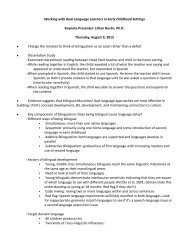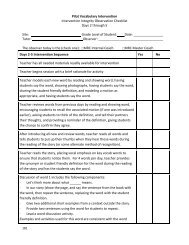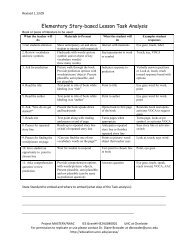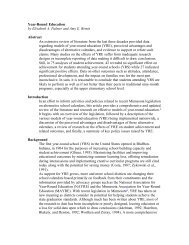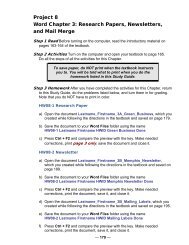Introduction to Positive Ways of Intervening with Challenging Behavior
Introduction to Positive Ways of Intervening with Challenging Behavior
Introduction to Positive Ways of Intervening with Challenging Behavior
You also want an ePaper? Increase the reach of your titles
YUMPU automatically turns print PDFs into web optimized ePapers that Google loves.
Maintenance and Generalization...<br />
behavior modification beyond the classroom<br />
This Intervention Tip Sheet has been developed <strong>to</strong> assist teachers and parents in providing the best possible<br />
educational opportunities <strong>to</strong> students <strong>with</strong> emotional and behavioral disorders. This Tip Sheet was published by<br />
the Institute on Community Integration, College <strong>of</strong> Education, University <strong>of</strong> Minnesota, Minneapolis and was<br />
authored by Kareen Smith <strong>of</strong> the Institute.<br />
<strong>Introduction</strong><br />
<strong>Behavior</strong> modification aims <strong>to</strong> change the antecedents and consequences <strong>of</strong> behavior <strong>to</strong> increase the likelihood <strong>of</strong><br />
appropriate behavior and decrease inappropriate behavior. The ultimate goal <strong>of</strong> behavior modification is that<br />
changes in behavior persist after the intervention is terminated and that behavior change occurs outside <strong>of</strong> the<br />
environment <strong>with</strong>in which behavior modification interventions are being carried out. These characteristics <strong>of</strong> a<br />
behavior intervention plan are referred <strong>to</strong> as maintenance and generalization, respectively. This guide should<br />
increase your understanding and appreciation <strong>of</strong> their importance, as well as provide guidelines <strong>to</strong> incorporate<br />
these aspects <strong>of</strong> behavior modification in<strong>to</strong> your intervention plan.<br />
Why do maintenance and generalization need <strong>to</strong> be programmed in<strong>to</strong> an intervention plan?<br />
Very <strong>of</strong>ten, changes in behavior achieved through behavior modification techniques are not maintained after the<br />
intervention has ended. This is <strong>of</strong>ten because there has been no deliberate planning for how <strong>to</strong> end the initial<br />
intervention and still maintain the behavior. For example, a student who is reinforced <strong>with</strong> cookies for keeping his<br />
desk neat may s<strong>to</strong>p cleaning his desk when cookies are <strong>with</strong>drawn as a reinforcer.<br />
Generalization is the degree <strong>to</strong> which a change in behavior will transfer <strong>to</strong> another setting or situation or the<br />
degree <strong>to</strong> which a behavior change program influences behaviors other than the target behavior. Generalization<br />
rarely happens spontaneously. For example, if you are teaching a student <strong>to</strong> raise her hand before speaking, you<br />
would like the student <strong>to</strong> display this behavior in appropriate situations other than your classroom. For this reason,<br />
generalization must be planned as part <strong>of</strong> the intervention.<br />
How do I begin <strong>to</strong> incorporate goals <strong>of</strong> maintenance and generalization in<strong>to</strong> my intervention<br />
plan?<br />
Zirpoli and Melloy (1993, p. 192) give the following guidelines for consideration when implementing<br />
maintenance and generalization:<br />
• Teach desired behaviors, whether they are social or academic, <strong>with</strong>in the natural setting where they<br />
should occur.<br />
• Employ a variety <strong>of</strong> caregivers for training (for example, several teachers, parents, peers). This decreases<br />
the probability that the behavior will become situation-specific.<br />
• Train in a variety <strong>of</strong> settings. If you must use a pull-out setting, establish some training <strong>with</strong>in the setting<br />
in which you want the behavior <strong>to</strong> occur.<br />
• Shift from artificial means <strong>of</strong> controlling the behavior (for example, <strong>to</strong>kens, prompts, or cues) <strong>to</strong> natural<br />
controls (praise, better grades, more classroom privileges). This can be accomplished by pairing natural<br />
<strong>with</strong> artificial controls and gradually decreasing (fading) the artificial controls as soon as possible.<br />
• Shift from continuous <strong>to</strong> intermittent and from fixed <strong>to</strong> variable schedules <strong>of</strong> reinforcement (see tip sheet<br />
entitled "Schedules <strong>of</strong> Reinforcement").




